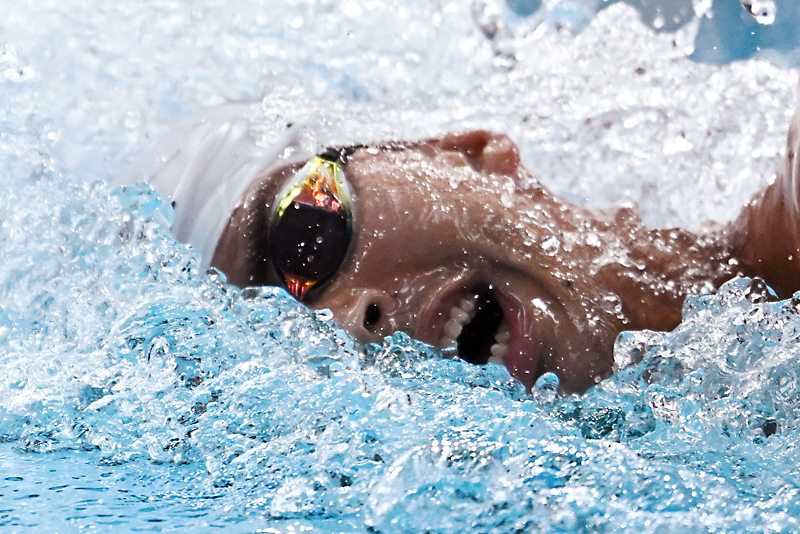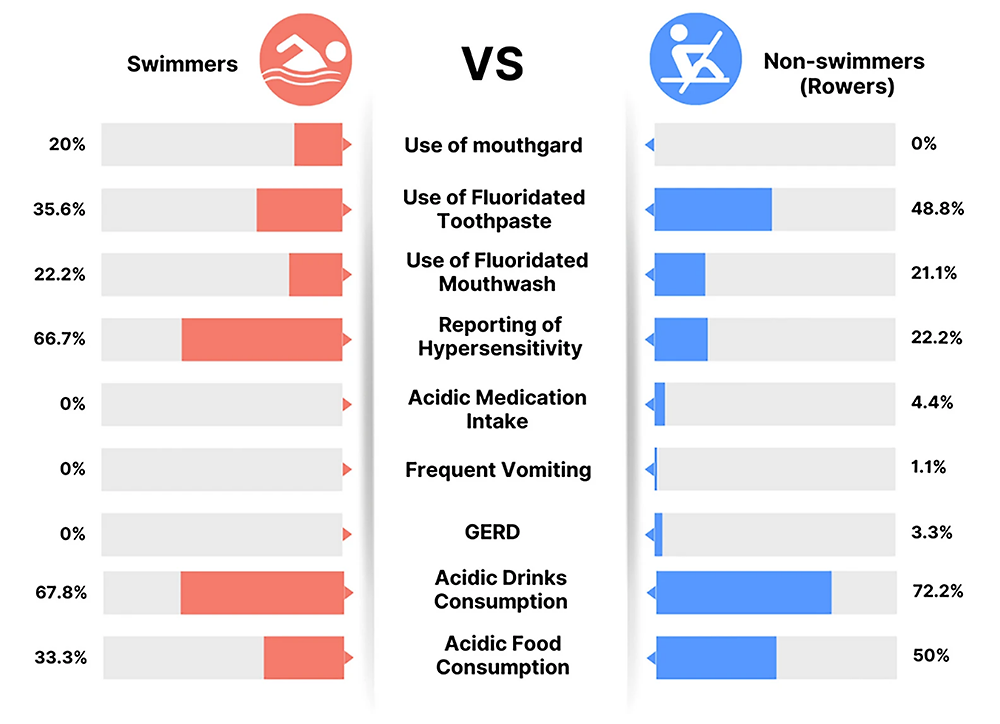You are viewing 1 of your 1 free articles. For unlimited access take a risk-free trial
Sports health: tooth truths for swimmers
SPB looks at new research on dental health in swimmers. Why are they at greater risk than other athletes and what steps can swimmers take to protect themselves?
While exercise and sport are good for health in so many ways, there are some potential health risks and downsides. The most obvious of these is injury, which can occur either as a result of over or incorrect training, or sports impacts and accidents – for example, collisions on the playing fields or tumbling off the bike because of slippery road conditions. Another potential risk concerns overtraining, which can lead to reduced immunity, chronic fatigue and even depression(1). Associated with overtraining, especially in younger female athletes, is the risk of developing an eating disorder (see this article). However, there’s a much lesser aspect of health and well being that can be negatively impacted by sports training and that’s dental health.
Dental erosion matters
How could training for sport negatively impact your dental health? One reason – especially in the case of endurance athletes – is an increased consumption of carbohydrate in the form of sports drinks to fuel longer workouts. Needless to say, these drinks invariably contain sugars (usually glucose or glucose/fructose mixtures), which provide a source of easily absorbed and digested carbohydrate. Unsurprisingly, consuming sugary drinks on a regular basis, especially when sipped over a period of time, is a great way to promote dental caries – in exactly the same way as happens in kids who eat too many sweets!
However, there’s another risk to dental health that if anything is more insidious than mere tooth decay, and that is something known as ‘dental erosion’, where the hard enamel coating on the teeth becomes gradually eroded. In a previous SP article, we looked at the topic of dental erosion in the context of consuming drinks that are acidic. These include fruit juices, lemonade, cordials and many sports drinks, which can result in an acidic environment around the teeth. This in turn can lead to demineralization and damage to the protective layer of enamel. Although this effect is not site specific (as is the case with caries), the frequent and repeated consumption of acidic drinks can, over time, erode and damage the enamel surface of the all the teeth in the mouth, greatly increasing the risk to dental health in future years.
Understanding dental erosion
Dental enamel is the hardest and most highly mineralized substance in the human body. The job of enamel is to protect the underlying dental tissue (dentine) during daily use – ie when chewing, biting, crunching, and grinding. Enamel also insulates the teeth from potentially painful temperatures and chemicals. Although tooth enamel is a completely biologically inert substance (ie having no blood supply), it is not a static tissue because it can undergo chemical changes that can cause demineralization and re-mineralization. In simple terms, exposing tooth enamel to acid (eg from acidic drinks) causes the gradual breakdown of the uppermost layer of enamel into soluble calcium, phosphate and water (demineralization).
Enamel erosion is insidious in that the early signs and symptoms may not set alarm bells ringing. These signs and symptoms include:
· Tooth sensitivity – either to hot or cold temperatures, or to certain foods such as sweet foods.
· Tooth rounding – the teeth can begin to take on a rounded and smooth appearance.
· Tooth discoloration – as the layer of protective enamel become progressive thinner, the teeth may appear yellow because more dentine is exposed.
In the later (more severe) stages of enamel erosion, sensitivity may be severe enough to cause a lot of pain. In addition, noticeable indentations may appear on the enamel surface of the teeth (known as ‘cupping’). Then of course, because the enamel surface becomes thin, small cavities are much more likely to breach the protective enamel layer, leading to tooth decay and infection (abscesses).
What makes an erosive drink?
Research has found that once the acidity of a drink exceeds a pH of around 5.5, dental erosion can occur(2). [Note that ‘pH’ is a measure of acidity/alkalinity; a neutral pH (that of water) is 7.0, with numbers below 7.0 indicating acidity and above 7.0 indicating alkalinity]. The same research found that the acidity of sports drinks can reach as much as pH 3.16 – ie 10,000 times more acidic than plain water! Fizzy drinks such as cola drinks (sweetened or unsweetened) are also culpable; the dissolved carbon dioxide lowers pH (ie increases acidity), which along with the flavourings (often acidic in themselves), further boosts dental erosion potential(3).
Not just drinks
While acidic drinks can be harmful for enamel health, that’s not the end of the story. That’s because there’s a link between exercise, saliva and dental erosion; exercise is known to have an adverse effect on the flow rate and composition of saliva, and physically active individuals show reduced stimulated salivary flow rates(4). Why does that matter? Well, saliva is the critical protective factor in the process of development of erosive lesions. Salivary flow encourages tooth remineralization, provides a buffering effect to resist pH changes in the mouth, and provides a replenishing supply of minerals to the demineralized tooth surface(5). Unsurprisingly therefore, those who exercise a lot have lower levels of salivation and are more likely to have a high prevalence of erosive wear lesions on the enamel(4).
The vulnerability of swimmers
Is if the above weren’t bad enough, it turns out that swimmers face another hurdle in maintaining their dental health, and it’s linked to chlorinated pool water. The recommendation is that to ensure an adequate antimicrobial effect while minimizing negative impacts to swimmers, swimming pool water should maintain chlorine level between 1.0 and 3.0 parts per million, and the pH range should be maintained between 7.2 and 8.0 – ie neutral to slightly alkaline(6).
For serious or elite swimmers undergoing high training loads and spending multiple hours per week in swimming pools, this presents a potential problem. That’s because improperly chlorinated swimming pools are often found to have low pH levels (ie acidic), with reports of pH values as low as 3.0 (due to the insufficient dosing of chemicals that can soak up excess pool acidity)(7). In such an environment, the constant exposure to erosive assaults by the acidic pool water means that swimmers’ teeth may become particularly susceptible to enamel erosion.
New research
Despite the concerns of increased risk of dental erosion in swimmers, there has been little recent research on this topic. In particular, there’s very little data comparing swimmers with other athletes undergoing a similar volume and intensity of training, and who are also likely to be consuming acidic sports beverages. But now, new research conducted by a team of Egyptian scientists has investigated exactly this topic(8). Published in the journal ‘Clinical Oral Investigations’, this study aimed to determine erosive tooth wear status and the related risk factors among 90 competitive swimmers (training in a number of different pools) compared to 90 competitive rowers.
What they did
The study design was quite simple. All the participants underwent a clinical examination of dental health by qualified dentists who used a recognized classification system – the ‘Basic Erosive Wear Examination’ system – to determine the status of erosive tooth wear in each participant. In addition, all the participants were interviewed to determine their personal risk factors for developing dental erosion. This included the amount of acidic drinks, foods and medications consumed, whether they used fluoridated toothpastes or mouth washes (which reduce the risk), and whether they used a mouthguard (which reduces risk – see figure 1). The reasoning was to try and control for the common factors between the swimmers and rowers, to tease out any additional risks posed by swimming in pool water.
Figure 1: Dental erosion risk and protective factors in the swimmers and rowers
The risk factors were fairly well balanced in the swimmers and rowers. The rowers reported a higher use of fluoridated toothpaste (protective) but this was balanced by mouthguard use (also protective) in 20% of the swimmers. Note however, that the reporting of teeth hypersensitivity (a sure sign of eroded enamel) was 3 x higher in the swimmers compared to the rowers!
The salivary flow of the swimmers and rowers was also measured before and after training. This was done with the use of chewing gum, where the athletes had to chew for five minutes without swallowing any saliva, whereupon the volume of saliva produced was measured each minute. Again this test was performed to make sure that any differences in dental erosion were not down to salivary flow.
Testing was carried out to determine pool water quality in all the pools where the swimmers were training. To ensure a comprehensive assessment, the pH measurements were conducted daily starting on the day of weekly swimming pool cleaning and chlorination, and for the next seven days. The pH of each swimming pool was measured twice daily from two different corners of the swimming pool at the start and end of the examination day (averaging about 10 hours per day per swimming pool). The second daily water sample was often collected during regular swimming training days when the pool was full of swimmers. This approach allowed the scientists to capture variations in water quality attributable to bathing load.
What they found
How did the dental health and the risk factors of the swimmers and the rowers compare? The main findings were as follows:
· The dental erosion risk exposure from drinks, foods and other factors were largely similar between the swimmers and rowers.
· Saliva flow rates in the swimmers and rowers were similar; although rates dropped after exercise, there were no significant differences in the decline between swimmers and rowers.
· Although these risk factors were similar, the incidence of tooth hypersensitivity (a red flag for dental erosion) in the swimmers was three times higher than in the rowers.
· The average swimming pool water pH level decreased in all swimming pools throughout the seven days of assessment. The highest reported average pH was 7.43 (ideal) while the lowest pH was 3.24 (extremely acidic!).
· Very importantly, erosive tooth wear was 2.5 times more prevalent in the competitive swimmers compared to the rowers (60.0% and 25.6%, respectively), with average Basic Erosive Wear Examination scores of 1.84 among the swimmers and 0.53 among the rowers.
· Nearly one third (30%) of the swimmers were at risk of enough dental erosion to require interventional strategies for management. In the rowers however, just 7% were at risk of erosive tooth wear, and of these, most were recommended only routine maintenance and observation.
· In the swimmers, greater dental erosion was correlated strongly with years of swimming practice. Each additional year of practice was associated with a 1.24 times higher risk of experiencing more erosive lesions. These results are consistent with a previous study, which found that swimmers who practiced for 10 years or more were had three times the risk of dental erosion compared to those who had swum for less than 10 years Lithuania(9).
Implications and practical advice for swimmers
The data in the study above suggests that swimmers ARE at significantly greater risk (two and a half times greater) of dental erosion than other athletes, who if you remember, are themselves at greater risk than the average member of the public. We can confidently draw this conclusion because in all other respects, the swimmers and the rowers were quite evenly matched for dental erosion risk factors. In addition, the pool water samples showed that for the majority of the swimmers’ training sessions, water acidity was above that recommended.
Of course, water quality and acidity will vary from pool to pool depending on how well the water is maintained. Nevertheless, most swimmers can expect to perform a significant chunk of their training hours in pool water that is far from ideal, thereby increasing their risk of dental erosion. Given what we know, how can swimmers minimize their risk of dental erosion? The good news is that there are a number of practical recommendations that can make a very positive impact, and markedly reduce your tooth exposure to acidity, thereby helping to minimize enamel damage. These are as follows:
- Try to organize your swim sessions at a pool with good water quality (ie where acidity is kept at acceptable levels). As a rule of thumb, larger pools run by local government or larger companies with extensive pool maintenance experience and mandated regulatory checks are likely to have better and more consistent water quality. However, this is not always the case as pool operator errors can and do happen! If you want to check pool water quality for yourself, you can request to see the pool maintenance logs with records of water quality measurement (any decent pool will have this data to hand).
- When you are in the pool, try to minimize the amount of you ingest and swill around the mouth.
- Upon leaving the pool, immediately drink some plain water to wash the teeth and remove any acidic pool water.
- When choosing sport drinks, select those with the lowest acidity possible (ie highest pH - preferably higher than 5.5). This is not easy however because the information on product labels rarely includes any reference to the drink’s pH value.
- Try and drink larger volumes of sports drink less often rather than constant sipping (thereby reducing tooth exposure time to sugar and acids).
- Don’t use sports drinks as a mouthwash – it’s far better to swallow the drink immediately, reducing tooth contact time.
- Try mixing a bit of skimmed milk into a sports drink (the calcium reduces acidity and helps protect the enamel. If you find the taste acceptable and it doesn’t cause you gastric distress, this is a good option.
- Get in the habit of drinking some skimmed milk after consuming any acidic drinks.
- Use an ‘enamel-kind’ or enamel-protecting/strengthening toothpaste – both morning and night time plus after training.
- Toothpastes high in xylitol (eg ‘Squigle’ in the US) are known to exert an enamel protective effect and may even help with remineralization – even when fluoride content is not especially high.
- Make sure you have regular dental check-ups; a dentist will be able to detect early signs of erosion and advise accordingly.
References
1. Eur J Appl Physiol Occup Physiol. 1992;64(4):335-44
2. Eur J Prosthodont Restor Dent. 2005 Dec;13(4):186-90
3. J Contemp Dent Pract. 2007 Nov 1;8(7):11-20
4. Arch Oral Biol 2015. 60:1639–1644
5. Sci Rep 2016. 6:34760
6. Water Treatment and Testing | Healthy Swimming | Healthy Water | CDC. www.cdc.gov/healthywater/swimming/residential/disinfection-testing.html. Accessed 10th November 2023
7. J Water Health 11:465–472
8. Clin Oral Investig. 2023 Nov 4. doi: 10.1007/s00784-023-05367-7. Online ahead of print
9. J Oral Maxillofac Res 2014 5:e6. doi.org/10.5037/jomr.2014.5206
Newsletter Sign Up
Testimonials
Dr. Alexandra Fandetti-Robin, Back & Body Chiropractic
Elspeth Cowell MSCh DpodM SRCh HCPC reg
William Hunter, Nuffield Health
Newsletter Sign Up
Coaches Testimonials
Dr. Alexandra Fandetti-Robin, Back & Body Chiropractic
Elspeth Cowell MSCh DpodM SRCh HCPC reg
William Hunter, Nuffield Health
Keep up with latest sports science research and apply it to maximize performance
Today you have the chance to join a group of athletes, and sports coaches/trainers who all have something special in common...
They use the latest research to improve performance for themselves and their clients - both athletes and sports teams - with help from global specialists in the fields of sports science, sports medicine and sports psychology.
They do this by reading Sports Performance Bulletin, an easy-to-digest but serious-minded journal dedicated to high performance sports. SPB offers a wealth of information and insight into the latest research, in an easily-accessible and understood format, along with a wealth of practical recommendations.
*includes 3 coaching manuals
Get Inspired
All the latest techniques and approaches
Sports Performance Bulletin helps dedicated endurance athletes improve their performance. Sense-checking the latest sports science research, and sourcing evidence and case studies to support findings, Sports Performance Bulletin turns proven insights into easily digestible practical advice. Supporting athletes, coaches and professionals who wish to ensure their guidance and programmes are kept right up to date and based on credible science.












